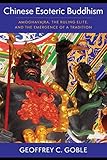Chinese Esoteric Buddhism : Amoghavajra, the Ruling Elite, and the Emergence of a Tradition / Geoffrey C. Goble.
Material type: TextSeries: The Sheng Yen Series in Chinese Buddhist StudiesPublisher: New York, NY : Columbia University Press, [2019]Copyright date: ©2019Description: 1 online resourceContent type:
TextSeries: The Sheng Yen Series in Chinese Buddhist StudiesPublisher: New York, NY : Columbia University Press, [2019]Copyright date: ©2019Description: 1 online resourceContent type: - 9780231194082
- 9780231550642
- 294.3/920951 23
- BQ8912.9.C5
- BQ8912.9.C5
- online - DeGruyter
- Issued also in print.
| Item type | Current library | Call number | URL | Status | Notes | Barcode | |
|---|---|---|---|---|---|---|---|
 eBook
eBook
|
Biblioteca "Angelicum" Pont. Univ. S.Tommaso d'Aquino Nuvola online | online - DeGruyter (Browse shelf(Opens below)) | Online access | Not for loan (Accesso limitato) | Accesso per gli utenti autorizzati / Access for authorized users | (dgr)9780231550642 |
Browsing Biblioteca "Angelicum" Pont. Univ. S.Tommaso d'Aquino shelves, Shelving location: Nuvola online Close shelf browser (Hides shelf browser)
Frontmatter -- Contents -- Acknowledgments -- Conventions and Abbreviations -- Introduction -- ONE. The Three Great Masters of Kaiyuan and the Teaching of the Five Divisions -- TWO. Esoteric Buddhism in Context -- THREE. Esoteric Buddhism in Context -- FOUR. Amoghavajra and the Ruling Elite -- FIVE. The Institutional Establishment of Esoteric Buddhism -- SIX. The Consolidation of Amoghavajra's Legacy -- Notes -- Bibliography -- Index
restricted access online access with authorization star
http://purl.org/coar/access_right/c_16ec
Chinese Esoteric Buddhism is generally held to have been established as a distinct and institutionalized Buddhist school in eighth-century China by "the Three Great Masters of Kaiyuan": Śubhākarasiṃha, Vajrabodhi, and Amoghavajra. Geoffrey C. Goble provides an innovative account of the tradition's emergence that sheds new light on the structures and traditions that shaped its institutionalization.Goble focuses on Amoghavajra (704-774), contending that he was the central figure in Esoteric Buddhism's rapid rise in Tang dynasty China, and the other two "patriarchs" are known primarily through Amoghavajra's teachings and writings. He presents the scriptural, mythological, and practical aspects of Chinese Esoteric Buddhism in the eighth century and places them in the historical contexts within which Amoghavajra operated. By telling the story of Amoghavajra's rise to prominence and of Esoteric Buddhism's corresponding institutionalization in China, Goble makes the case that the evolution of this tradition was predicated on Indic scriptures and practical norms rather than being the product of conscious adaptation to a Chinese cultural environment. He demonstrates that Esoteric Buddhism was employed by Chinese rulers to defeat military and political rivals. Based on close readings of a broad range of textual sources previously untapped by English-language scholarship, this book overturns many assumptions about the origins of Chinese Esoteric Buddhism.
Issued also in print.
Mode of access: Internet via World Wide Web.
In English.
Description based on online resource; title from PDF title page (publisher's Web site, viewed 02. Mrz 2022)









